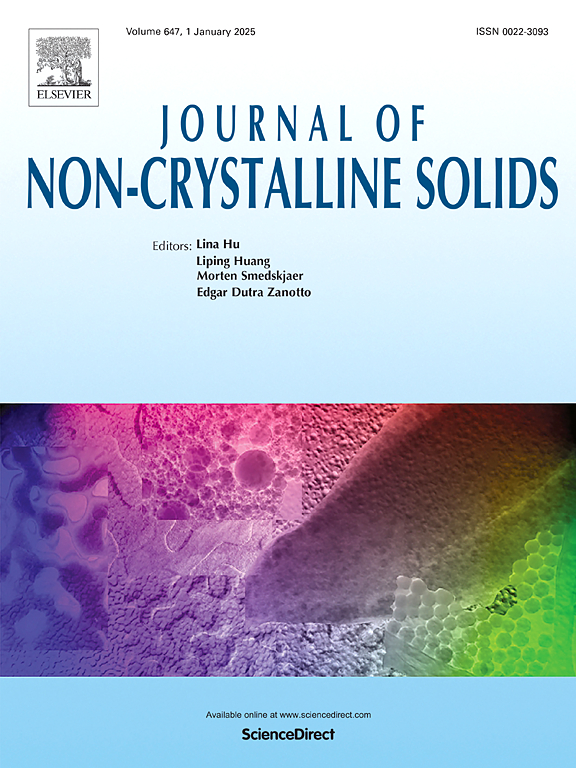Cross-scale investigation into the regulation of basalt melt structure evolution and fiber forming performance via Y2O3 doping
IF 3.5
3区 材料科学
Q1 MATERIALS SCIENCE, CERAMICS
引用次数: 0
Abstract
This study integrated multi-scale characterization techniques with molecular dynamics simulations to systematically investigate the regulatory mechanism by which Y2O3 doping influences the structural evolution of basalt melt and its fiber formability. The stability of the melt structure was optimized by adjusting the addition amount of Y2O3. The results show that Y2O3 with a dosage of 1 wt% significantly reduces the liquid phase temperature of the system, enhances the uniformity of the melt, and lowers the brittleness index. The spinnable temperature range is broadened, with the maximum spinnable temperature reaching a range of 80 °C. The fiber exhibits an average diameter of 10.41 μm and a tensile strength of up to 2099 MPa. Fourier infrared spectroscopy (FTIR) analysis reveals that the degree of polymerization of the glass network initially increases and subsequently decreases with increasing Y2O3 content. X-ray photoelectron spectrometer (XPS) results confirm that Y3+ repairs structural defects in the melt through the formation of Y-O-Si bonds. Molecular dynamics simulations further reveal that the doping concentration of Y3+ induces dynamic coordination reconstruction of aluminum-oxygen polyhedra. The incorporation of a small amount of Y3+ promotes the transformation of Al from [AlO6] to [AlO4] coordination, thereby increasing the BO content and strengthening the melt network structure. This finding provides a theoretical foundation for expanding the drawing temperature window in basalt fiber preparation and improving the fiber's tensile strength.
Y2O3掺杂对玄武岩熔体结构演化和纤维形成性能调控的跨尺度研究
本研究将多尺度表征技术与分子动力学模拟相结合,系统研究了Y2O3掺杂对玄武岩熔体结构演化及其纤维成形性的调控机制。通过调整Y2O3的加入量,优化了熔体结构的稳定性。结果表明:添加1wt %的Y2O3能显著降低体系液相温度,提高熔体的均匀性,降低脆性指数;可纺温度范围扩大,最高可纺温度可达80℃。该纤维的平均直径为10.41 μm,抗拉强度为2099 MPa。傅里叶红外光谱(FTIR)分析表明,随着Y2O3含量的增加,玻璃网络的聚合度先增大后减小。x射线光电子能谱(XPS)结果证实,Y3+通过形成Y-O-Si键来修复熔体中的结构缺陷。分子动力学模拟进一步揭示了Y3+掺杂浓度诱导铝氧多面体的动态配位重构。少量Y3+的加入促进了Al由[AlO6]配位向[AlO4]配位的转变,从而增加了BO含量,强化了熔体网络结构。这一发现为扩大玄武岩纤维制备中的拉伸温度窗,提高纤维的抗拉强度提供了理论依据。
本文章由计算机程序翻译,如有差异,请以英文原文为准。
求助全文
约1分钟内获得全文
求助全文
来源期刊

Journal of Non-crystalline Solids
工程技术-材料科学:硅酸盐
CiteScore
6.50
自引率
11.40%
发文量
576
审稿时长
35 days
期刊介绍:
The Journal of Non-Crystalline Solids publishes review articles, research papers, and Letters to the Editor on amorphous and glassy materials, including inorganic, organic, polymeric, hybrid and metallic systems. Papers on partially glassy materials, such as glass-ceramics and glass-matrix composites, and papers involving the liquid state are also included in so far as the properties of the liquid are relevant for the formation of the solid.
In all cases the papers must demonstrate both novelty and importance to the field, by way of significant advances in understanding or application of non-crystalline solids; in the case of Letters, a compelling case must also be made for expedited handling.
 求助内容:
求助内容: 应助结果提醒方式:
应助结果提醒方式:


